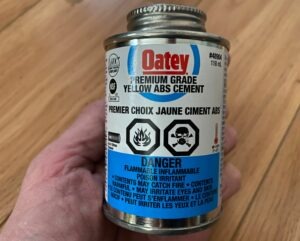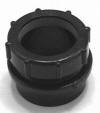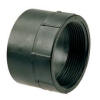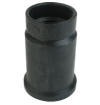Acrylonitrile butadiene styrene, better known as “ABS”, is a very installation friendly piping system that requires little time or special tools for cutting and joining ABS in order to make a water/air tight joint. ABS is used solely for drainage, waste and vent (DWV) in plumbing systems and is not used in pressurized applications.
Joining ABS Using a Glued Joint
 The use of an approved solvent cement (glue) is the primary method for joining ABS pipe and fittings and does not require the use of a primer. When the solvent cement is applied to the pipe and fittings, it quickly begins to soften and dissolve the plastic surface. Once coupled together, it will create a joint that is actually stronger than the pipe itself.
The use of an approved solvent cement (glue) is the primary method for joining ABS pipe and fittings and does not require the use of a primer. When the solvent cement is applied to the pipe and fittings, it quickly begins to soften and dissolve the plastic surface. Once coupled together, it will create a joint that is actually stronger than the pipe itself.
When creating an ABS glued joint:
- Always ensure the pipe is cut squarely and deburred so that maximum penetration into the fitting is achieved;
- The surface of the ABS where glue is to be applied must be free of water, dirt, oil and identification stickers;
- Always apply glue (cement) to both surfaces. For example: on the end of the pipe and inside the fitting hub (for drying reasons, applying cement to the inside of the fitting hub first is considered proper plumbing practices);
- Once the glue is placed on the ABS, a completed joint should be made within 30 seconds or the solvent will begin to set. This time frame will be reduced in hot dry weather;
- Insert the pipe completely to the bottom of the fitting’s socket and give it a quarter turn, holding the joint securely for several seconds, and let go;
- Always allow at least 30 minutes and up to 24 hours depending on the ambient temperature and relative humidity, for the for the joint to set before testing it.
Threaded ABS Joints
Although schedule 40 ABS pipe is not permitted to be threaded by using taps or dies, there are both male and female threaded adapter fittings that may be used to connect to other piping systems or to provide a cleanout access.
When creating a threaded ABS joint:
- Never use any petroleum based thread sealant compounds (such as pipe dope) as it will deteriorate the pipe, use only Teflon tape or other ABS approved thread sealants;
- Never over tighten the joint as the fittings are prone to cracking, a good rule of thumb is one full turn past hand tight.
Adapting ABS To Other Piping Systems
When renovating or repairing a drainage system it is often necessary to join ABS to other piping materials, this is easily accomplished with a variety of transition fittings, as seen below:
 Mechanical fittings, often referred to by the brand name “Fernco“, are available for transitioning ABS to copper, galvanized, cast iron, clay and most other pipe materials you may encounter.
Mechanical fittings, often referred to by the brand name “Fernco“, are available for transitioning ABS to copper, galvanized, cast iron, clay and most other pipe materials you may encounter.
 Slip-joint Adapters – are used for connecting to the tail piece of fixture outlet pipes. The are only permitted in accessible areas and will usually create a water tight seal with only hand tightening.
Slip-joint Adapters – are used for connecting to the tail piece of fixture outlet pipes. The are only permitted in accessible areas and will usually create a water tight seal with only hand tightening.
ABS to Cast Iron soil pipe adapter – using the fittings shown to the left, an ABS pipe could be connected to the bell end of a Cast Iron soil pipe. The flexible rubber adapter is called a “donut” and will be very difficult to fit into the bell, I find a hammer and lots of plumber’s grease works well.
 Transition cement – is used for the connection of ABS to PVC pipe, it is not used to replace the proper solvent cement for like material joints.
Transition cement – is used for the connection of ABS to PVC pipe, it is not used to replace the proper solvent cement for like material joints.



